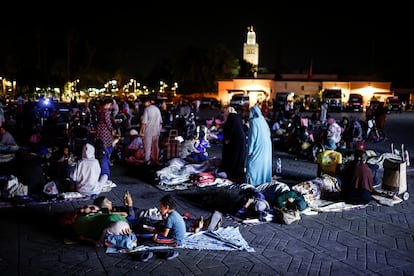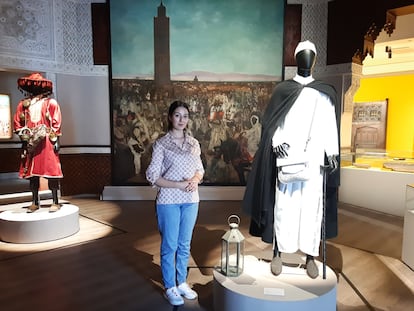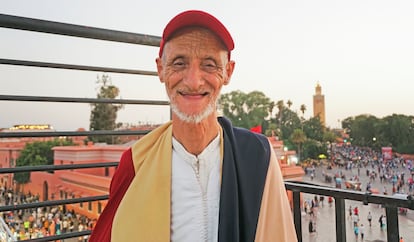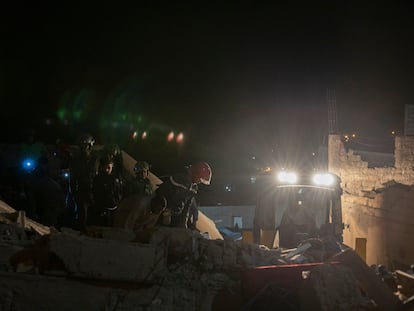Marrakech, a UNESCO city of heritage, but also of words and history
The oral tradition of storytellers that led to the Jemaa el-Fnaa square being named Intangible Heritage of Humanity is in danger of disappearing as its practitioners are pushed out by mass tourism


Marrakech’s historic center, a UNESCO World Heritage Site, suffered the consequences of the biggest earthquake ever recorded in Morocco, which struck late on September 8 and resulted in over 2,000 deaths. Dozens of buildings in the Medina collapsed and a minaret in the emblematic Jemaa el-Fnaa square collapsed. The damage was particularly intense in the Mellah, the old Jewish quarter, which was covered with rubble at midnight on Friday, shortly after the seismic shock. But UNESCO’s World Heritage declaration does not only extend to the buildings and streets of the Moroccan city, but to something beyond bricks and mortar, a custom that gathers centuries of language and history: the oral tradition of storytellers, which is also in danger, overwhelmed by mass tourism.
“Two girls grew up in the same neighborhood and both got married on the same day. Before long, they had children on the same day.” Dressed in the cloak of traditional storytellers, the septuagenarian Mohamed Sghir Erguibi, began his story, shortly before the earthquake, at sunset on the rooftop terrace of the Grand Café Glacier, which opens onto Jemaa el-Fnaa square. The halka, the groups that formed on the legendary esplanade around gnawa musicians, groups of acrobats, soothsayers, and snake charmers, now hardly feature storytellers. Their voices seemed to have been silenced by the racket of the square, and their audience had run out of space in the face of the expansion of the sea of food stalls. This weekend, Jemaa el-Fnaa became a communal dormitory where hundreds of families who have been left homeless by the earthquake slept in the open air.
Marrakech has become a hugely popular tourist destination. Arrivals from Spain, for example, increased by 80% during the first six months of 2023 compared to the same period before the pandemic in 2019, according to the latest official data available. But Erguibi no longer has anyone to listen to his tale in Jemaa el-Fnaa. He arrived for the interview with a folder full of press clippings and certificates accrediting him as an authorized storyteller. He also carried with him the memories of the Marrakech-based Spanish writer Juan Goytisolo, who in 1997 started promoting the declaration of the square as Intangible Heritage of Humanity, a status granted by UNESCO in 2008.

“One of the mothers stayed in the neighborhood and her son became imam of the mosque. The other left for a faraway place after being abandoned by her husband. Her son worked as a peddler in a market, until one day he found a bag with 10,000 dirhams [$1,070, a fortune for the time of the tale],” continued the veteran storyteller. “People who come to the square now have no interest in old stories anymore,” he laments, “and we make a living as best we can in hotels and festivals with short comic stories.”
“There are only seven storytellers left who are still able to offer traditional storytelling in public, and they are all approaching 80,” says Hanae Jerjou, curator at the Museum of Intangible Cultural Heritage of Marrakech, inaugurated earlier this year in the former headquarters of Morocco’s central bank, Al Maghreb. In this unique, restored building in Jemaa el-Fnaa, she offers a tour of the square through time and the arts, such as the works of the French orientalist painter Jacques Majorelle or movie posters that made the Ochre City famous, like Alfred Hitchcock’s The Man Who Knew Too Much.

“The risk of this intangible heritage disappearing is real, especially because it has been passed down from parents to children, who listened to the stories in the square from an early age,” says Jerjou. In recent years, schools have sprung up in associations and cafés in the Medina for a new generation that is trying to recover the legacy of traditional storytelling. Events such as the Marrakech International Storytelling Festival are helping to revive interest in the art.
Erguibi recovers the thread of the tale: “With the million cents [the 10,000 dirhams] he found, the young man bought luxurious gifts for his mother and even for the father who had abandoned them. Their former friend went to visit them with her son, the imam. They were both surprised to see their wealth.” After the pandemic, which emptied the heart of Marrakech, the old storytellers have not returned to the emblematic square, damaged today by the worst earthquake Morocco has ever suffered.
Zouhair Jaznaoui, 25, better known by his Instagram alias of Zouhair the Storyteller, runs the artistic storytelling troupe Fanus (which means oil lamp) in Marrakech. “I maintain a close relationship with the old storytellers,” he explains in the new town, far from a Jemaa el-Fnaa square that he sees today more as a business center than a place for artists, where its original name comes from. He studied with Haj Ahmed Ezargani, now a nonagenarian, and other traditional storytellers.
“There are no storytellers left. Before the pandemic, the square had its own ecosystem in which more than 30 specialized storytellers with their assigned zones were active,” says Jaznaoui, who aspired to renew oral storytelling in Marrakech. “Institutionalization marked the decline of the halka. I learned traditional storytelling, but now I try to innovate, to reinterpret it, even with new technologies,” says Jaznaoui, “with the idea of telling stories in a more structured way, but respecting the essence of the original sources, not the academic theory.” The same story can dazzle or lull, depending on the storyteller who brings it to life with his or her voice.
Jaznaoui doesn’t believe storytellers are dying out. “They are adapting. Now there is no room and no audience in the square for the old formula.” He thinks tourists, like the travelers in the old caravans, will always continue to flock to Marrakech. “They come for Jemaa el-Fnaa. But if we put an end to the spirit of the square, who will come?”

One Thousand and One Nights
Five years ago, Madonna created her own version of One Thousand and One Nights to celebrate her 60th birthday in Marrakech with dozens of friends. Goytisolo spent more than two decades in the same Medina house where he died in 2017, proudly proclaiming himself a “son of the square.”
Mohamed Sghir Erguibi, who retains a vivid memory of the Spanish writer, tells all kinds of tales. “They are my stories, like the two friends who got married on the same day,” he explains after pausing his story while Jemaa el-Fnaa falls silent during the evening prayer and the sun dips behind the minaret of the Kutubiyya Mosque. The emblematic landmark shook during the earthquake and some rubble fell from it, but reportedly it has suffered no structural damage.
“The peddler’s mother gave a lot of money to the friend who had come to visit him,” Erguibi continues back at the café. “She told her son, the Islamic cleric, everything. ‘Leave the mosque and go to the market. There people find bags of money and get rich,’ she encouraged him. ‘Doesn’t anyone think about the person who lost the bag and may now be suffering from poverty? Actually, it’s as if we all robbed him,’ replied the young imam.”
Erguibi lights a cigarette at the end of the story while he savors a studied silence for the audience to ponder the moral of easy money. The weathered storyteller points to his ancestral place in Jemaa el-Fnaa. “Our time is up,” he acknowledges. “We’ve been promised that next year they’re going to put up a small stage in a place away from the noise. But young people no longer tell stories in the square. They go to cafes and hotels,” he laments. “And it’s a shame, because this square is itself an incomparable fairy tale.”
Sign up for our weekly newsletter to get more English-language news coverage from EL PAÍS USA Edition
Tu suscripción se está usando en otro dispositivo
¿Quieres añadir otro usuario a tu suscripción?
Si continúas leyendo en este dispositivo, no se podrá leer en el otro.
FlechaTu suscripción se está usando en otro dispositivo y solo puedes acceder a EL PAÍS desde un dispositivo a la vez.
Si quieres compartir tu cuenta, cambia tu suscripción a la modalidad Premium, así podrás añadir otro usuario. Cada uno accederá con su propia cuenta de email, lo que os permitirá personalizar vuestra experiencia en EL PAÍS.
¿Tienes una suscripción de empresa? Accede aquí para contratar más cuentas.
En el caso de no saber quién está usando tu cuenta, te recomendamos cambiar tu contraseña aquí.
Si decides continuar compartiendo tu cuenta, este mensaje se mostrará en tu dispositivo y en el de la otra persona que está usando tu cuenta de forma indefinida, afectando a tu experiencia de lectura. Puedes consultar aquí los términos y condiciones de la suscripción digital.
More information
Archived In
Últimas noticias
Most viewed
- Sinaloa Cartel war is taking its toll on Los Chapitos
- Oona Chaplin: ‘I told James Cameron that I was living in a treehouse and starting a permaculture project with a friend’
- Reinhard Genzel, Nobel laureate in physics: ‘One-minute videos will never give you the truth’
- Why the price of coffee has skyrocketed: from Brazilian plantations to specialty coffee houses
- Silver prices are going crazy: This is what’s fueling the rally










































